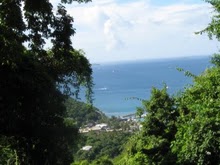 |
| Canada Goose in flight |
The trouble is that each subspecies is difficult to distinguish from another unless one looks very closely and apparently observing the Geese in family groups rather, than individually is more helpful in that regard. In the case of the Cackling Goose
 The only reliable means of comparing neck length is if the geese are in flight; the only time their neck is stretched straight out. In the picture directly above two of the geese appear to have necks that are very much shorter when compared to the third, yet they do not seem very much smaller in body size when compared to the longer necked goose. Since I do not have pictures where these geese are perfectly aligned side by side it is rather difficult to tell.
The only reliable means of comparing neck length is if the geese are in flight; the only time their neck is stretched straight out. In the picture directly above two of the geese appear to have necks that are very much shorter when compared to the third, yet they do not seem very much smaller in body size when compared to the longer necked goose. Since I do not have pictures where these geese are perfectly aligned side by side it is rather difficult to tell. |
| Goose with white ringed neck |
When trying to identify any of the subspecies, color does not seem to be a reliable indicator unless you see the geese in groups, where one group may exhibit lighter coloring and another darker, and even then apparently there is no guarantee of correct identification. The only exception to this is the Giant Canada Goose, who is more black on the body than the typical brownish gray of the others. Marking such as a white band around the neck just above the chest is not a reliable indicator, nor are white spots on the head of the goose, even though only certain subspecies are supposed to exhibit them. Apparently the best way to separate one species, or subspecies from the next would be to see Geese from more than two or three of the various species in the same place so that comparisons can be made.
 |
| Lone Goose |
A very good indicator to help you identify a species of Canada Goose is location. Here in Alberta it is the Moffitti subspecies of Canada Goose that is likely to be seen, where as in Hudson's Bay area in Ontario you are more likely to see a Giant Canada Goose, and Cackling Geese can be seen in Alaska or along the coastline of the Yukon. That does not rule out the possibility of seeing a Cackling Goose or another subspecies of Canada Goose here in Alberta however, since the lines of breeding ranges often overlap.
Having seen pictures of the smallest of the subspecies of Cackling Geese, it is unlikely that any of the geese featured in my photos are Cackling Geese. I do not doubt that I would be able to recognize the smallest Cackling Goose immediately. However, I would have to have a lot more information and expertise in order to even attempt to identify each of the individual Canada Geese you see here into accurate subspecies categories.
Some very helpful sites for identifying the different subspecies and species of Canada Goose are listed below:
http://www.sibleyguides.com/2007/07/identification-of-cackling-and-canada-goose/
http://www.dfw.state.or.us/resources/hunting/waterfowl/goose-permits/WillametteLColGooseGuide_081707.pdf
http://www.idahobirds.net/identification/white-cheeked/introduction.html
http://www.agjv.ca/index.php?option=com_content&task=view&id=16&Itemid=56
Enjoy,
Susan













No comments:
Post a Comment